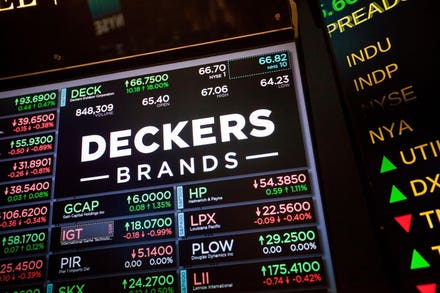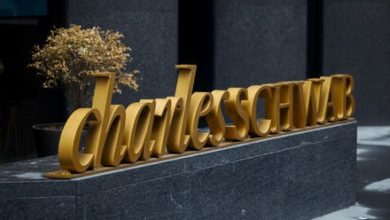Is Deckers Outdoor Stock A Buy Because Of Stock Split?

© 2017 Bloomberg Finance LP
Shares of Deckers Outdoor have returned more than 500% in the past five years, as the footwear company makes steady inroads into a market previously dominated by Nike and Adidas, thanks to its superior profitability profile and product innovation. Is DECK stock still a buy after its outsized gains, as it begins to trade at more accessible post-stock-split price points starting September 17?
What Is Deckers Outdoor?
Deckers Outdoor designs and sells footwear, apparel and accessories for casual lifestyle uses and high-performance activities. Its portfolio of brands includes UGG, Koolaburra, Hoka, Teva and AHNU.
Hoka produces premium performance footwear and apparel for athletes. This is the major slice of the revenue pie and a primary growth driver for Deckers Outdoor. UGG, a lifestyle brand known for its iconic suede Classic boots, is a fast-growing premium line with 130 concept and outlet stores in key international markets, including New York, San Francisco, Los Angeles, Paris, London, Tokyo, Shanghai and Beijing. UGG partners with top retailers globally. Combined, Hoka and UGG brands represented more than 90% of Deckers Outdoor’s topline in the recent first quarter of 2025, kicking off the fiscal year on a strong note and well positioned for the rest of the year amid strong demand. Deckers is hoping to rebrand UGG from a trend-centric approach to a year-round, upscale model. Koolaburra, an UGG variant, comes at more affordable price points and dominates Deckers’ “other brands” business.
The Teva brand makes sandals for outdoor activities, but has been struggling with flailing sales. For the most recent first-quarter, Teva’s net sales fell 4.3% year over year to $46.3 million. However, Deckers is hoping to revive the brand.
After being discontinued in 2018, Ahnu has been relaunched by Deckers as a “super sneaker” brand, that incorporates vintage running shoe designs with modern performance materials for all-day comfort.
Deckers Outdoor’s Stock Split Details
Given the strong gains in its share price in the past years, Deckers Outdoor is implementing a 6-for-1 stock split to make its common stock more affordable for a broader class of investors, including its employees, while increasing the trading liquidity of its common shares. The stock split has been approved by its shareholders. Previously, Deckers implemented a 3-for-1 stock in July 2010.
The stock split is applicable to all common and preferred shares outstanding as on September 6, although Deckers has no preferred shares outstanding as of now. DECK shareholders on record as of September 6, will receive five additional shares for every share owned, after market close on September 16. Starting September 17, DECK stock will start trading on a post-split basis.
Much more than breaking news, our diverse reporting digs deeper with unparalleled insights that empower you to make better informed decisions. Become a Forbes member and unlock unlimited access to cutting-edge strategies, actionable insights, and updated analysis from our network of leading finance experts.
How Stock Splits May Impact Share Prices
A stock split only adjusts the number of shares and the price of each share, but the post-split value of the stock holdings held by a shareholder remains the same as its pre-split value. The stock split has no impact on business fundamentals, it only makes the stock more affordable for a broader investment community. When high-priced stocks like DECK split, it is usually perceived as a welcome move by investors, because of affordability and the availability of more shares for trading. However, investment decisions should never be based on a stock split solely. While there are no guarantees that a stock will run up before or after a split, stocks typically tend to run up by 2% to 4%, around the split announcement.
Chipotle Mexican Grill (CMG) implemented a huge 50-for-1 stock split on June 26, representing one of the biggest stock splits in the history of the New York Stock Exchange (NYSE). Chipotle made the announcement on March 19. The closing price of CMG on March 19 was $55.95. The stock rallied and closed at a new high of $68.55 on June 18 (roughly a week before the split). On June 26, the first day of post-split trading, the stock closed at $65.86. The last trading price of CMG was $56.12 as of September 13. So, the stock traded higher after the stock split announcement and up to the implementation of the same, but is now roughly 18% off its adjusted June highs. One of the key reasons for the stock cooling off is the departure of its popular CEO Brian Niccol, who played a crucial role in building the fortunes of CMG. Niccol left to pursue an opportunity with Starbucks so there is no red flag here.The dip is likely to be temporary given CMG’s popular growth recipe and strong playbook, and may be an opportunity to buy into a quality business.
The stock price is more influenced by underlying business fundamentals, and corporate developments as well as macroeconomic headwinds/tailwinds, including Fed decisions, state of the economy, and geopolitical tensions. Stock split merely renders the stock more affordable, facilitating buying, but is not an indicator to buy or sell a stock.
Current Market Performance of Deckers Outdoor
Deckers Outdoor Vs. Nike
Shares of Deckers Outdoor have outperformed the S&P 500 in the year to date, one-year, two-year and five-year periods. Deckers has beaten EPS and revenue estimates in the last eight quarters in a row, thanks to its product innovation, growth in direct-to-consumer (DTC) channels, targeted store expansion and international growth with a strategic focus on profitable markets, and a robust wholesale business. Deckers reported an upbeat first quarter in late July, and the stock ran up 9% through late August from its pre-earnings closing price of $894.70 on July 26, before the recent selloff. DECK stock closed Friday’s trade at $935.07.
Nike, the giant sneaker brand, on the other hand, is struggling with stalling sales due to challenges in its online business, planned declines in classic footwear franchises, softer sales outlook for China, and uneven consumer trends across Nike’s markets. As a result, Nike cut guidance for fiscal 2025, now expecting revenues to decline in the mid-single digits vs. prior projections for growth vs. consensus estimate for a 0.9% increase. Nike also expects sales in the first half to be down in the high single digits, compared to previous guidance of declines in the low single digits. Nike shares have not only underperformed the S&P 500 in the year-to-date, one-year, two-year and five-year periods, but also recorded negative returns in these periods.
Deckers is experiencing robust growth in DTC channels in the past years. For the recent first quarter, DTC sales increased 24% year over year to $310.6 million, while DTC comparable net sales increased 21.9%. DTC sales represented nearly 38% of first quarter business, and Deckers Outdoor expects to raise this metric to 50% of the overall business.
Nike’s pivot to a DTC-centric strategy, which led to severing ties with retail partners like Big 5 Sporting Goods, Dunham’s Sports, Urban Outfitters, Dillard’s and Zappos, has not panned out well for the brand. For the recent fourth quarter, Nike’s direct revenues fell 8% year over year to $5.1 billion. But, Nike is making amends now and slowly rebuilding its relationship with retail partners, which is evident in its recent fourth-quarter wholesale revenue rising 5% to $7.1 billion. While focussing on the buildout of its direct channels, Nike somewhat neglected innovation, the core strength that has distinguished its brand.
Deckers’ Hoka brand has been taking market share from Nike and continues to be the primary sales growth driver. When Deckers acquired Hoka in 2012, Hoka’s sales were in the $3 million range. In the recent first quarter, Hoka’s sales rose 30% year over year to $545 million (representing 66% of the top line) as the brand enjoyed healthy full-price demand across global markets. Deckers grows its Hoka brand by adding new distribution partners and via global marketing campaigns. New launches, healthy growth of topstyle Hoka brands Clifton and Bondi, and emerging franchises like Mach (now a top-five revenue style for Hoka in the first quarter), Transport and Kawana, (the light hiker and fitness shoes now among Hoka brand’s top10 styles ranked by revenue) contributed to Hoka’s strong performance in the first quarter. The Cielo X1 and Skyward X, Hoka’s daily-performance trainers lineup, outperformed expectations during the first quarter. The Skyward X is designed for casual walkers and runners, while the Cielo X1 is for athletes and professionals that competes with Nike’s Alphafly.
Deckers’ UGG brand, which was acquired in 1995, became more popular after Oprah Winfrey’s endorsement in 2003. Sales for the UGG brand rose above $1 billion in 2013, and reached $2.24 billion in fiscal 2024 as comfort takes precedence over looks among the growing demographic of younger shoppers. For the most recent first quarter, UGG sales were $223 million (up 14% year over year). During the quarter, the UGG brand experienced strong full-price selling with increased year round momentum, increased adoption of the expanding Golden Collection, continued momentum in global DTC, and robust wholesale growth in the US. The Tasman franchise and Golden Collection were the key drivers of the UGG brand’s DTC success in the first quarter, in the U.S. and international regions. Deckers said UGG, which has year-round demand, is on track to deliver another year of healthy growth with premium products and elevated experiences.
After a long lull in innovation, Nike is rolling up its sleeves and gearing for new product releases. In April, Nike debuted the new Nike Pegasus Premium running shoe with its first visible Air Zoom unit, utilizing ZoomX and ReactX foams to boost speed and enhance runners’ energy return. The Nike Blueprint Pack, a selection of footwear equipped with Air technology will be a multi-sport wear. Nike Athlete Imagined Revolution(AIR), a new initiative that involves a co-creation process between Nike designers and 13 professional athletes to develop future Air products. Bank Of America analysts see Nike returning to growth with new products and plans to shift its sneaker offerings away from some of its classic styles, including Air Force 1s.
Deckers said its international growth was most meaningful in China and EMEA as both regions drove strong increases online and benefited from successful recent retail store openings. Deckers already has more Hoka stores in China vs. any other country and is planning a more aggressive retail-buildout in China.
Nike experienced a traffic decline in China for the fourth quarter, but sales of $1.86 billion in the region, beat Wall Street estimates of $1.79 billion. Nevertheless, Nike warned of softer sales outlook in China for the near-term because of the highly promotional nature of the China marketplace.
DECK trades at lofty valuations compared to the sector median and its own historical five-year average on every valuation metric compared to Nike, which trades at a forward 25x Price-to-earnings (P/E) multiple below its own 5-year average of 35.4x.
Much more than breaking news, our diverse reporting digs deeper with unparalleled insights that empower you to make better informed decisions. Become a Forbes member and unlock unlimited access to cutting-edge strategies, actionable insights, and updated analysis from our network of leading finance experts.
Deckers Outdoor’s Financial Health
Healthy revenue and profitability trajectory, strong balance sheet
In the last three years, Deckers Outdoor’s revenues have grown to $4.3 billion in 2024 from $3.2 billion in 2022 and are expected to rise by 10% year over year to $4.7 billion in fiscal 2025, ending on March 31, 2025. For the most recent first quarter, revenues rose 22.1% year over year to $825.3 million.
Hoka and UGG brands contributed more than 90% of revenues in the first quarter. The U.S. continues to be the top revenue contributor accounting for nearly 63% of total first-quarter revenues, while international revenues accounted for 37%. It should be noted that wholesale is a larger part of the revenue mix, representing roughly 62% of the top line in the first quarter, while the rest was generated from DTC sales.
The Koolaburra, a more affordable option of the UGG franchise, is a key contributor for Deckers Outdoor’s Other segment, which reported net sales of $4 million for the first quarter, up 123.5% from the year-ago period.
Income from operations has grown to $927.5 million in 2024 from $564.7 million in 2022. First-quarter operating income rose to $132.8 million from year-ago $70.7 million. Net income has grown to $759.6 million or $29.16/share in 2024 from $451.9 million or $16.26 per share in 2022, and guided to a range of $29.75 to $30.65 for fiscal 2025. First quarter net income rose to $115.6 million or $4.52 per share from year-ago $63.6 million or $2.41 per share.
Deckers has maintained its gross margins above 50% in the last three years and expects to see 54% for fiscal 2025. Gross margin for the first quarter wass 56.9% vs. year-ago 51.3%, benefitting from full-price selling of Hoka and UGG brands vs. year-ago period that witnessed more promotional selling.
Operating margin has varied between 18% and nearly 22% in the last three years and is expected to be between 19.5% and 20% for fiscal 2025. Cash and cash equivalents were $1.4 billion at June 30, 2024 compared to $1.1 billion in June 30, 2023. Deckers had no outstanding borrowings.
Other Key Takeaways
Organic growth would be the focus for now not mergers & acquisitions. Deckers Outdoor expects to reactivate Teva, and focus on category expansion opportunities within Hoka and UGG, like men’s opportunities in UGG and apparel opportunity in Hoka.
Deckers Outdoor plans to roll out UGG retail stores in flagship cities. With one on Fifth Avenue, New York, and a new store in Knightsbridge in London, the company is seeking flagship locations in Asia and China.
For Hoka, the strategy for opening retail stores will be more aggressive, but nothing as massive as rolling out 200 stores. An enhanced focus on international markets, DTC expansion for consumer acquisition and retention gains, and performance innovations will drive the Hoka strategy forward.
HOKA is still expected to grow approximately 20% in fiscal 2025, while UGG is expected to grow in the mid-single-digit range. FY 2025 is expected to be a year of wholesale growth.
Specific to Hoka, Deckers expects to see expansion with key retail partners, both domestically and internationally, including DSG, JD, both in the U.S., in Europe and Asia, Intersport in Europe, Foot Locker, as well as Topsports in China and Sport Chek in Canada.
Deckers Outdoor noted that its Mach 6 is gaining traction. A Bondi update will launch in February of 2025 and Clifton 10 will debut in fiscal 2026 giving these products time to breathe.
As for returns to shareholders, buybacks are in the cards, and a dividend discussion is on with its board although Deckers has nothing concrete to announce as of now.
Freight rates are anticipated to be a headwind for the remainder of this year. Deckers expects the full-year impact of freight on gross margins to be a negative 80 bps.
Growth in the subsequent quarters will slow down vs. harder year-ago comparisons, but Deckers Outdoor will still deliver top-line growth of around 10% for fiscal 2025.
Stock Split Short-Term And Long-Term Outlook
The recent pre-stock-split runup in the DECK stock may likely lead to some near-term weakness after the split, offering a buying opportunity. The fundamentals look very promising, but blistering valuations of the DECK stock should likely give investors a pause given that growth in the subsequent quarters may slow down in the face of strong year-ago comparisons and align with the management’s 10% revenue growth guidance for fiscal 2025. The promotional environment is expected to normalize and Deckers expects to see less full-price selling for its top brands. Rising freight rates are also seen as moderate headwinds for margins. While selling by insiders is usually planned and may have no bearing on business fundamentals, it must be noted that on September 6, 2024, David Powers, Director at Deckers Outdoor sold 3,912 DECK shares at $863.08 apiece. Following this transaction, the insider now directly owns 68,078 shares in the company.
As for the longer-term, Deckers Outdoor operates in a dynamic consumer space, where loyalties run low and shift quickly to the next thing of interest. There is plenty of competition in the footwear space, and Nike is stepping up its game with new products planned, and setting up for a comeback. With its longer roots and deeper pockets, the turnaround for Nike may likely happen sooner than later.
But, Deckers has a well-balanced strategy with targeted store openings, less promotional spending, giving breathing space to existing products before new product launches and focusing on organic and profitable growth vs. growing through expensive acquisitions.
The company has clearly outlined its vision of not chasing numbers and seeking sustainable, healthy, profitable growth for years to come. This may be the best way to go. Deckers Outdoor shares have great long-term prospects, as long as the footwear maker keeps its product innovation relevant to the fickle and shifting audience, but valuation should likely normalize to sustainable levels.
Is Deckers Outdoor Stock A Buy Now?
DECK stock is overvalued now but may likely experience some near-term weakness after a strong pre-split runup, presenting a buying opportunity later. The stock is a “Hold” for me now, given its expected slow down in the subsequent quarters for the rest of the year vs. tougher year-ago comparisons. The gross margins may likely face some pressure due to rising freight rates and lesser full-price selling amid a normalizing promotional environment.
That said, Decker Outdoor’s positioning for international expansion, category expansion opportunities with Hoka apparel and UGG men’s, alongside its well-balanced operational strategy should sit well with long-term investors. DTC sales will be a larger part of the business mix and selective retail outlets for top brands should drive the growth strategy forward. Expansion of retail partnerships and shelf-space will continue to support Deckers Outdoor.
Please note that I am not a registered investment advisor and readers should do their own due diligence before investing in this or any other stock. I am not responsible for the investment decisions made by individuals after reading this article. Readers are asked not to rely on the opinions and analysis expressed in the article and encouraged to do their own research before investing.
Read Next
- What Is Fundrise: The App That Makes Investing In Real Estate And REITs Easy
- 5 Top EV Stocks To Buy Beyond Tesla
- All 41 Stocks Warren Buffett Has In Berkshire Hathaway’s Portfolio
Much more than breaking news, our diverse reporting digs deeper with unparalleled insights that empower you to make better informed decisions. Become a Forbes member and unlock unlimited access to cutting-edge strategies, actionable insights, and updated analysis from our network of leading finance experts.



